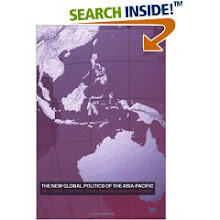September 14, 2007
How Terrorism Experts Get it Wrong
Excerpted from “War on Error and the Southern Fire: How Terrorism Experts Get it Wrong” in Critical Asian Studies, 2006
Michael Connors
Citations in the original.
…Terrorism studies has its origins in studies of violence in the Middle East and in
Western Europe. In decline during the 1990s, the sub-discipline found new impetus
after the 11 September 2001 attacks in the United States. What does terrorism
studies offer? Over a decade ago, Mike Smith noted that twenty years of
terrorism studies had failed to generate much genuine insight into the dynamics
of local conflicts. The literature tended toward high-level generalizations
around tactical modality and causality that emerged from superficial comparative
analysis of incommensurable conflicts (for example, the IRA and the Red
Army Faction in West Germany).10 Smith asked: “So who are the experts on terrorism?
Answer, there are no experts, just people who know a little about a lot of
small conflicts.”11 This insight is significant, for it implies that so-called experts
on terrorism have little to offer relative to conflicts they are unfamiliar with.12 As
will be shown, [Rohan Gunaratna’s] Conflict and Terrorism is a good example of Smith’s thesis: forall its pretense about being an up-to-date manual on the violence in South Thailand, the book was produced by authors who seemingly know little about Thailand,
but who are equipped with the language of terrorism studies.
Burnett and Whyte, in their more recent review of terrorism studies, or
“terrorology,” note that during the 1990s a complex interaction of government-
sponsored research programs, think tanks, and academics produced a
discourse on “new terrorism” that informs post-9/11 commentary. The “new
terrorism” (hereafter without quotation marks) thesis claimed to be about a terrorism
that dispensed with traditional structures of hierarchy and command,
that was prone to use weapons of mass destruction, that was indiscriminate in
its targets, and that was pathological and beyond rational engagement.13 Such
ideas have informed much of the contemporary writing on terrorism, leading to
a politicized academic literature siding with the U.S.-driven “war on terror”
(hereafter without quotation marks). Conflict and Terrorism shares some of
these traits, although its conclusion that Thailand remains as yet a localized
struggle allows it to escape from an overzealous application of the new terrorism
thesis. Nevertheless, it is the shadow of the threat of new terrorism that
lurks behind the book’s examination of international linkages, and explains
why the book will interest terrorism analysts (59–68).14
Something also needs to be said about the current context in which writings
on terrorism are produced. This is a period in which terrorism analysts operate
in a tense civilizational, geopolitical, and ideological context that inevitably colors
their output. Even if Samuel Huntington’s “clash of civilizations” thesis is
pure ideological and ethnocentric fury, it has captured the disposition of some
terrorism analysts who can but view Islam with suspicion; this is so for the authors
of Conflict and Terrorism (104). It is also noteworthy that the securitization
of U.S. foreign policy, whereby economic liberalization policies have been
trumped by pressure to conform to U.S. security policies, has led to greater
claims on U.S. allies in the so-called war on terror, leading to a global retreat
from human rights and democracy.15 In the West this has meant highly politicized
news reporting, often quoting academics sympathetic to the war on terror.
These reports typically conflate local conflicts with “terrorism” and downplay
human rights abuses. Conflict and Terrorism does raise some concerns
about excessive use of force in Thailand, but it tends to see the state as being
forced into repressive measures as a result of terrorist strategy (see discussion
below on Tak Bai). Furthermore, the intensification of relations between intelligence
agencies and universities provides an opportunity for some analysts to
conform to state policies and agendas and to downplay issues of “state terror.”16
It is true that many terrorism analysts are legitimately concerned with the root
local causes and trigger factors for acts of terrorism, and attempt broad-based
analyses that run counter to state interests. Such work shows up the shallow nature
of some media and academic commentary.17 But the pressure to follow
state interests and the rewards this subservience brings have increased in the
post-9/11 environment, increasing the number of opportunists in the field.18
This politicized environment has lowered the bar on the standards of analysis
and research for some terrorism analysts.
For the well-connected terrorism analyst, research extends to connections
with intelligence agencies and access to secret documents—selectively offered,
of course. Often welcomed into the corridors of power, s/he is the civilian face
of networks of intelligence that have their own agendas to advance. The politically
significant function of such opportunists, who identify or work closely
with governments, is to take the conclusions of intelligence agencies into the
public sphere in modified form, and lend such conclusions legitimacy by virtue
of being an apparently independent mouthpiece.19 Backed with megabucks for
research, sought out by police commissioners and security ministers, and
courted by media, such analysts feel free to comment on any act of terror anywhere,
anytime. This commentary-promiscuity is why they so often get it wrong.
Michael Connors
Citations in the original.
…Terrorism studies has its origins in studies of violence in the Middle East and in
Western Europe. In decline during the 1990s, the sub-discipline found new impetus
after the 11 September 2001 attacks in the United States. What does terrorism
studies offer? Over a decade ago, Mike Smith noted that twenty years of
terrorism studies had failed to generate much genuine insight into the dynamics
of local conflicts. The literature tended toward high-level generalizations
around tactical modality and causality that emerged from superficial comparative
analysis of incommensurable conflicts (for example, the IRA and the Red
Army Faction in West Germany).10 Smith asked: “So who are the experts on terrorism?
Answer, there are no experts, just people who know a little about a lot of
small conflicts.”11 This insight is significant, for it implies that so-called experts
on terrorism have little to offer relative to conflicts they are unfamiliar with.12 As
will be shown, [Rohan Gunaratna’s] Conflict and Terrorism is a good example of Smith’s thesis: forall its pretense about being an up-to-date manual on the violence in South Thailand, the book was produced by authors who seemingly know little about Thailand,
but who are equipped with the language of terrorism studies.
Burnett and Whyte, in their more recent review of terrorism studies, or
“terrorology,” note that during the 1990s a complex interaction of government-
sponsored research programs, think tanks, and academics produced a
discourse on “new terrorism” that informs post-9/11 commentary. The “new
terrorism” (hereafter without quotation marks) thesis claimed to be about a terrorism
that dispensed with traditional structures of hierarchy and command,
that was prone to use weapons of mass destruction, that was indiscriminate in
its targets, and that was pathological and beyond rational engagement.13 Such
ideas have informed much of the contemporary writing on terrorism, leading to
a politicized academic literature siding with the U.S.-driven “war on terror”
(hereafter without quotation marks). Conflict and Terrorism shares some of
these traits, although its conclusion that Thailand remains as yet a localized
struggle allows it to escape from an overzealous application of the new terrorism
thesis. Nevertheless, it is the shadow of the threat of new terrorism that
lurks behind the book’s examination of international linkages, and explains
why the book will interest terrorism analysts (59–68).14
Something also needs to be said about the current context in which writings
on terrorism are produced. This is a period in which terrorism analysts operate
in a tense civilizational, geopolitical, and ideological context that inevitably colors
their output. Even if Samuel Huntington’s “clash of civilizations” thesis is
pure ideological and ethnocentric fury, it has captured the disposition of some
terrorism analysts who can but view Islam with suspicion; this is so for the authors
of Conflict and Terrorism (104). It is also noteworthy that the securitization
of U.S. foreign policy, whereby economic liberalization policies have been
trumped by pressure to conform to U.S. security policies, has led to greater
claims on U.S. allies in the so-called war on terror, leading to a global retreat
from human rights and democracy.15 In the West this has meant highly politicized
news reporting, often quoting academics sympathetic to the war on terror.
These reports typically conflate local conflicts with “terrorism” and downplay
human rights abuses. Conflict and Terrorism does raise some concerns
about excessive use of force in Thailand, but it tends to see the state as being
forced into repressive measures as a result of terrorist strategy (see discussion
below on Tak Bai). Furthermore, the intensification of relations between intelligence
agencies and universities provides an opportunity for some analysts to
conform to state policies and agendas and to downplay issues of “state terror.”16
It is true that many terrorism analysts are legitimately concerned with the root
local causes and trigger factors for acts of terrorism, and attempt broad-based
analyses that run counter to state interests. Such work shows up the shallow nature
of some media and academic commentary.17 But the pressure to follow
state interests and the rewards this subservience brings have increased in the
post-9/11 environment, increasing the number of opportunists in the field.18
This politicized environment has lowered the bar on the standards of analysis
and research for some terrorism analysts.
For the well-connected terrorism analyst, research extends to connections
with intelligence agencies and access to secret documents—selectively offered,
of course. Often welcomed into the corridors of power, s/he is the civilian face
of networks of intelligence that have their own agendas to advance. The politically
significant function of such opportunists, who identify or work closely
with governments, is to take the conclusions of intelligence agencies into the
public sphere in modified form, and lend such conclusions legitimacy by virtue
of being an apparently independent mouthpiece.19 Backed with megabucks for
research, sought out by police commissioners and security ministers, and
courted by media, such analysts feel free to comment on any act of terror anywhere,
anytime. This commentary-promiscuity is why they so often get it wrong.
Subscribe to:
Post Comments (Atom)






No comments:
Post a Comment